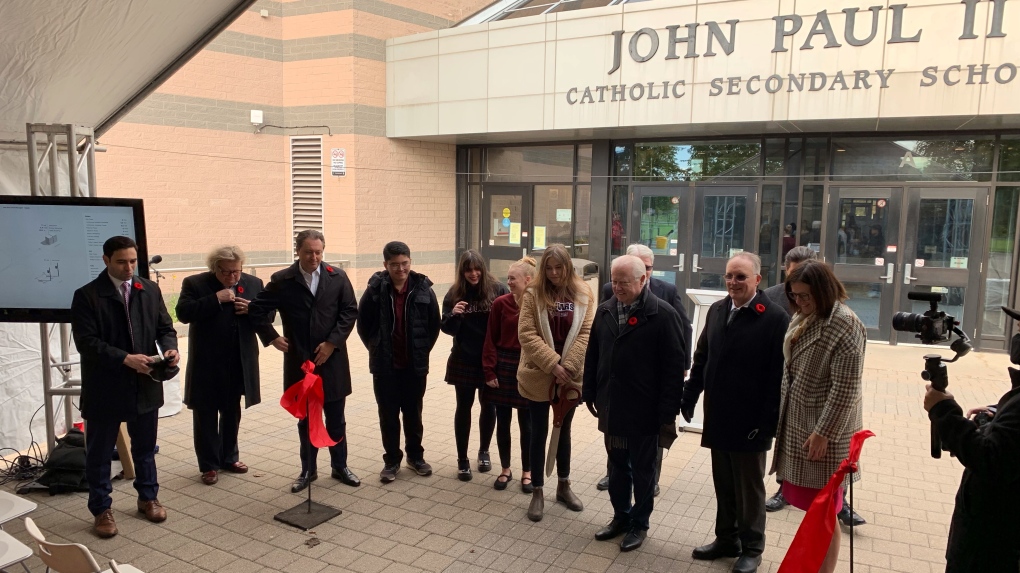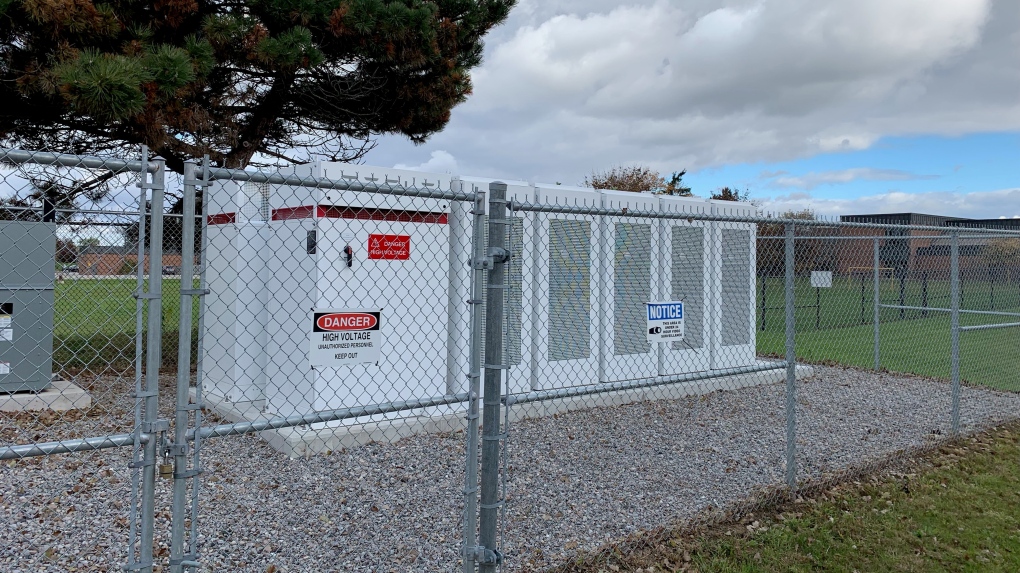John Paul II becomes first self-sufficient carbon neutral school in Canada
John Paul II Catholic Secondary School in London, Ont. has become the first school in Canada to become energy self-sufficient and carbon neutral.
A ribbon-cutting ceremony was held Tuesday for the official unveiling of the green mega project -- a collaboration of industry and government, and students themselves.
“We’re aware of what’s going on in the world and it’s amazing to really put our feet down and say we want better, we want better for our future generations,” said Grade 13 student Sarah Bedor, who was among the students who got hands-on experience working on the project. “We’re willing to commit to that, and so this project has shown.” A ribbon cutting ceremony for the official unveiling of the green mega project at John Paul II Secondary School, Nov. 2, 2021. (Bryan Bicknell / CTV News)From the roadway it looks like a giant carport, but it’s quite a bit more sophisticated. The project consists of 2,700 covered solar panels that generate 825 kilowatts of power.
A ribbon cutting ceremony for the official unveiling of the green mega project at John Paul II Secondary School, Nov. 2, 2021. (Bryan Bicknell / CTV News)From the roadway it looks like a giant carport, but it’s quite a bit more sophisticated. The project consists of 2,700 covered solar panels that generate 825 kilowatts of power.
Natural gas is no longer required to heat the school because the new system employs heat pumps to bring outside air in to heat or cool the school.
According to the London District Catholic School Board, the retrofit reduces greenhouse gas emissions to near zero and removes roughly 277 tonnes of carbon per year, “which not only makes it completely self sufficient, but also reduces baseline electricity costs by almost 70 per cent,” said Director of Education Vince Romeo.
 Tesla energy storage system at John Paul II Catholic Secondary School in London, Ont., Nov. 2, 2021. (Bryan Bicknell / CTV News)Equipped with a Tesla energy storage system, the microgrid supplies energy to London Hydro and the provincial grid, according to Jim Fonger, VP of renewable energy firm Ameresco, the main industry partner involved in the project.
Tesla energy storage system at John Paul II Catholic Secondary School in London, Ont., Nov. 2, 2021. (Bryan Bicknell / CTV News)Equipped with a Tesla energy storage system, the microgrid supplies energy to London Hydro and the provincial grid, according to Jim Fonger, VP of renewable energy firm Ameresco, the main industry partner involved in the project.
“It kind of lives in, we’ll call it a symbiotic nature with the local grid, in that sometimes it’s taking from it and sometimes it’s supporting it,” said Fonger. “But at all times the school actually gets what it needs.”
School Principal Peter Cassidy added, “It’s my understanding, that even in the early going, the system is working as efficiently or more, than it had been anticipated.”
The $9.7-million project was jointly funded by Ameresco and senior levels of government and is expected to pay for itself in about 25 years.
CTVNews.ca Top Stories

'Unity': Assembly of First Nations National Chief Cindy Woodhouse Nepinak sums up 2024
The Assembly of First Nations National Chief Cindy Woodhouse Nepinak’s first year as leader has been one of unity, she said in an interview with CTV News.
Uninspired Canada upset by Latvia in a shootout at world juniors
Eriks Mateiko scored the only goal of the shootout as Latvia stunned an alarmingly uninspired Canada 3-2 at the world junior hockey championship Friday.
Trudeau, Carney push back over Trump's ongoing 51st state comments
Two senior members of the federal cabinet were in Florida Friday pushing Canada's new $1.3 billion border plan with members of Donald Trump's transition team, a day after Prime Minister Justin Trudeau himself appeared to finally push back at the president-elect over his social media posts about turning Canada into the 51st state.
B.C. man who flipped 14 homes in four years is fined $2M for tax evasion
A serial property flipper in British Columbia has been convicted of tax evasion and fined more than $2 million for failing to report nearly $7.5 million in earnings.
Calgary Boxing Day crash victim identified, mother and sister still in hospital
A nine-year-old girl has died in hospital after the vehicle she was in was struck by a driver in a stolen vehicle fleeing from police.
Missing dog returns to Florida family, rings doorbell
After a nearly weeklong search, Athena, a four-year-old German Shepherd and Husky mix, found her way home to her Florida family in time for Christmas Eve and even rang the doorbell.
'Home Alone' director Chris Columbus explains how the McCallisters were able to afford that house
Audiences have wondered for years how the family in 'Home Alone' was able to afford their beautiful Chicago-area home and now we know.
Scheffler to miss tournament after injuring hand making Christmas dinner
Scottie Scheffler will miss The Sentry tournament next month after the world number one suffered an accidental puncture wound to his right hand preparing Christmas dinner and had to have surgery, the PGA Tour said on Friday.
'Nobody should have to go through that': N.B. family grieving father, daughter killed in crash
A New Brunswick family is grieving the loss of a father and daughter in a crash.


































